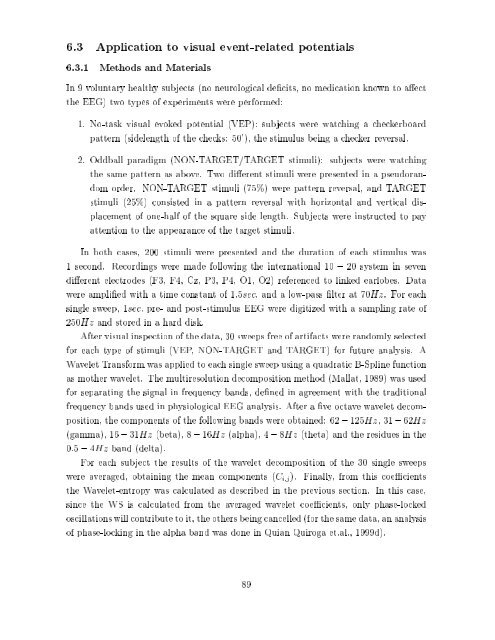Quantitative analysis of EEG signals: Time-frequency methods and ...
Quantitative analysis of EEG signals: Time-frequency methods and ...
Quantitative analysis of EEG signals: Time-frequency methods and ...
You also want an ePaper? Increase the reach of your titles
YUMPU automatically turns print PDFs into web optimized ePapers that Google loves.
6.3 Application to visual event-related potentials<br />
6.3.1 Methods <strong>and</strong> Materials<br />
In 9 voluntary healthy subjects (no neurological decits, no medication known to aect<br />
the <strong>EEG</strong>) two types <strong>of</strong> experiments were performed:<br />
1. No-task visual evoked potential (VEP): subjects were watching a checkerboard<br />
pattern (sidelength <strong>of</strong> the checks: 50'), the stimulus being achecker reversal.<br />
2. Oddball paradigm (NON-TARGET/TARGET stimuli): subjects were watching<br />
the same pattern as above. Two dierent stimuli were presented in a pseudor<strong>and</strong>om<br />
order. NON-TARGET stimuli (75%) were pattern reversal, <strong>and</strong> TARGET<br />
stimuli (25%) consisted in a pattern reversal with horizontal <strong>and</strong> vertical displacement<br />
<strong>of</strong> one-half <strong>of</strong> the square side length. Subjects were instructed to pay<br />
attention to the appearance <strong>of</strong> the target stimuli.<br />
In both cases, 200 stimuli were presented <strong>and</strong> the duration <strong>of</strong> each stimulus was<br />
1 second. Recordings were made following the international 10 ; 20 system in seven<br />
dierent electrodes (F3, F4, Cz, P3, P4, O1, O2) referenced to linked earlobes. Data<br />
were amplied with a time constant <strong>of</strong> 1:5sec: <strong>and</strong> a low-pass lter at 70Hz. For each<br />
single sweep, 1sec: pre- <strong>and</strong> post-stimulus <strong>EEG</strong> were digitized with a sampling rate <strong>of</strong><br />
250Hz <strong>and</strong> stored in a hard disk.<br />
After visual inspection <strong>of</strong> the data, 30 sweeps free <strong>of</strong> artifacts were r<strong>and</strong>omly selected<br />
for each type <strong>of</strong> stimuli (VEP, NON-TARGET <strong>and</strong> TARGET) for future <strong>analysis</strong>. A<br />
Wavelet Transform was applied to each single sweep using a quadratic B-Spline function<br />
as mother wavelet. The multiresolution decomposition method (Mallat, 1989) was used<br />
for separating the signal in <strong>frequency</strong> b<strong>and</strong>s, dened in agreement with the traditional<br />
<strong>frequency</strong> b<strong>and</strong>s used in physiological <strong>EEG</strong> <strong>analysis</strong>. After a ve octave wavelet decomposition,<br />
the components <strong>of</strong> the following b<strong>and</strong>s were obtained: 62 ; 125Hz,31; 62Hz<br />
(gamma), 16 ; 31Hz (beta), 8 ; 16Hz (alpha), 4 ; 8Hz (theta) <strong>and</strong> the residues in the<br />
0:5 ; 4Hz b<strong>and</strong> (delta).<br />
For each subject the results <strong>of</strong> the wavelet decomposition <strong>of</strong> the 30 single sweeps<br />
were averaged, obtaining the mean components (C ij ). Finally, from this coecients<br />
the Wavelet-entropy was calculated as described in the previous section. In this case,<br />
since the WS is calculated from the averaged wavelet coecients, only phase-locked<br />
oscillations will contribute to it, the others being cancelled (for the same data, an <strong>analysis</strong><br />
<strong>of</strong> phase-locking in the alpha b<strong>and</strong> was done in Quian Quiroga et.al., 1999d).<br />
89




